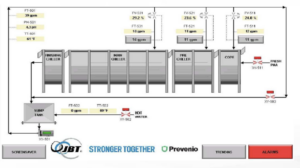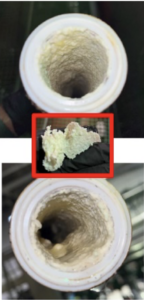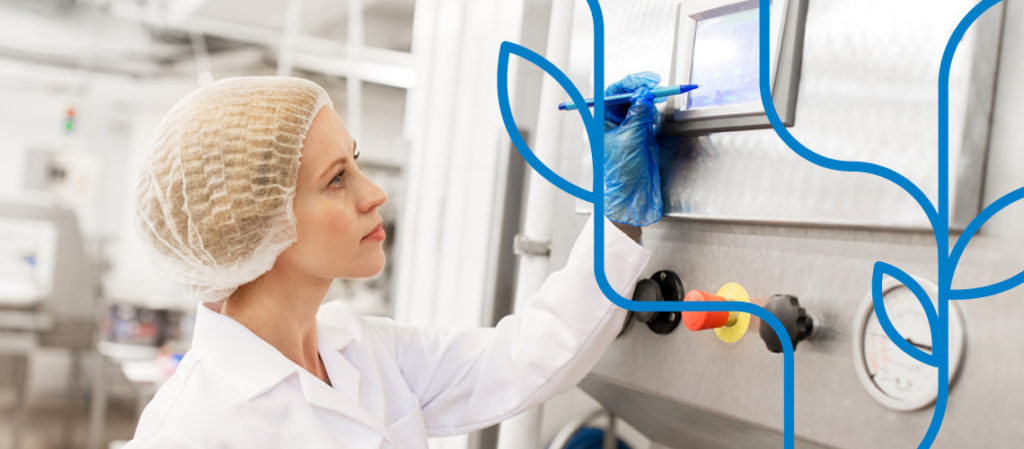The protein processing industry is known for its high consumption of water and chemicals, especially during primary processing and chilling of poultry. However, JBT Prevenio™ has developed a solution to reduce this consumption. The Automated Recycle and Cleaning System (ARC) captures overflow water from chillers and recycles it by distributing it back throughout the chiller body during processing, reducing 5 to 7 million gallons of water per year.
How the ARC System Works in Poultry and Fish Processing Facilities
Prevenio’s Automated Recycle and Cleaning System (ARC) is a water recycling solution for protein processing facilities. The ARC system also decreases chemical consumption by over 10%. This not only saves water and chemicals, but it also prevents the disposal of potentially harmful substances down the drain.
The ARC system is fully automated and operates during processing. After daily chilling, an operator can enable CIP (Clean in Place) mode, and the system will automatically clean itself according to industry best practices. This reallocates labor associated with manual cleaning and ensures that the system is cleaned to the highest standards. The ARC system is best suited to integrate with JBT’s line of C.A.T.TM Chillers but can be used with any brand of chiller.

Reductions in Water and Chemical Consumption
Prevenio’s Automated Recycle and Cleaning System (ARC) is making a significant impact in the sustainability efforts in protein processing facilities. This system captures and reuses water from the chiller systems in protein processing facilities, reducing both water and chemical consumption.
One of the unique aspects of the ARC system is its ability to split the captured water and distribute it to multiple points in the chiller system. This helps to maximize the water savings and reduce the amount of water that would typically go to waste water.
According to case studies from facilities using the ARC system, the results are impressive. One facility has seen a 20% reduction in water used in the chilling system and a 10% reduction in total PAA consumption. Another facility has seen a savings of 7 million gallons of water in processing and 123 gallons of PAA per day.

Not only does the ARC system provide sustainability benefits, but it also has a quick return on investment. The average ROI for the ARC system is 8 months, depending on the volume of the plant.
The Benefits of Automated Cleaning
 A typical challenge of recirculating water is the buildup of Biofilm throughout the piping as displayed in the picture below, which can be difficult to clean. Unlike traditional systems, the ARC features a Clean in Place (CIP) system that automatically cleans the recirculation piping, eliminating the buildup of biofilm that can be detrimental to microbial performance.
A typical challenge of recirculating water is the buildup of Biofilm throughout the piping as displayed in the picture below, which can be difficult to clean. Unlike traditional systems, the ARC features a Clean in Place (CIP) system that automatically cleans the recirculation piping, eliminating the buildup of biofilm that can be detrimental to microbial performance.
Typically, cleaning pipes manually is a time-consuming process that requires significant labor. However, with the ARC, the cleaning process is automatic, allowing companies to reallocate that labor to other areas.
The ARC’s cleaning time can occur in under an hour with a single push of a button compared to the several hours it would take to manually clean pipes to the same standard. This not only saves time, but also ensures that the pipes are clean and ready for use for the next shift, boosting the overall performance of the system
A Key Part of JBT Corporation’s Sustainability Strategy
The Automated Recycle and Cleaning System (ARC) developed by Prevenio is a game-changing solution for the poultry and fish processing industry. Its ability to recycle water and reduce chemical usage makes it a valuable tool in the fight against waste in the protein processing industry. Not only does it reduce water and chemical consumption, but it also ensures that the cleaning process is efficient and effective.
This helps improve the industry’s sustainability, offers a quick return on investment, and allows companies to reallocate labor to other areas. The ARC system is an excellent addition to JBT Corporation’s sustainability strategy and is a great example of how technology can help to improve environmental performance in the food processing industry.

